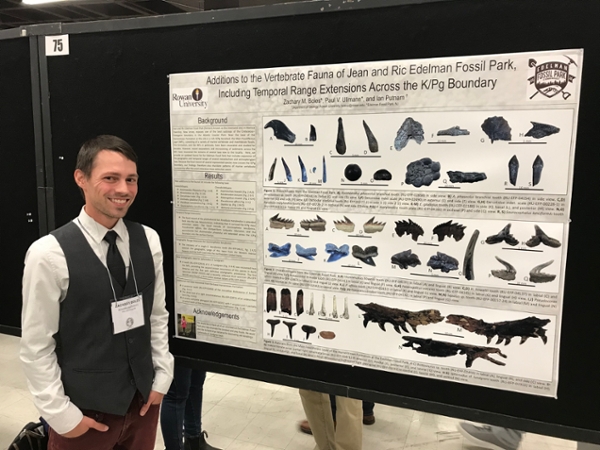Edelman Fossil Park research sheds light on regional shark and fish biodiversity 66 million years ago
Edelman Fossil Park research sheds light on regional shark and fish biodiversity 66 million years ago

Newly published Rowan University research from the Jean & Ric Edelman Fossil Park & Museum in Mantua Township confirms that some sharks and other fish, which were thought to have existed only off the West Coast or off Europe, also lived along the Atlantic coastline.
Dr. Zachary Boles, lecturer in the Department of Geology in Rowan’s School of Earth & Environment, said a recent study published in the journal Acta Palaeontologica Palonica confirmed the discoveries.
“We added at least 11 new sharks and fish to the Edelman Fossil Park fauna list,” said Boles, the study’s lead author. “They’re known species but hadn’t been found at the park. The bigger picture is, some of those fossils expand the known geographic range of the sharks and fish. Some were only known from the western U.S. or other parts of the globe.”
Among them, Boles said, the shark Notidanodon brotzeni had previously been known to exist only in the waters off Sweden and New Zealand.
The fish Saurocephalus lanciformis, another new find in northeastern North America, was previously known to exist only in the western interior and off the gulf coast while the fish Phyllodus paulkatoi was previously known only from waters in areas that are now Montana and Wyoming.
The study, “New vertebrate microfossils expand the diversity of the chondrichthyan and actinopterygian fauna of the Maastrichtian–Danian Hornerstown Formation in New Jersey,” published April 12.
Many of the ancient teeth collected at the Fossil Park for the study were discovered through micro sieving, a process in which material is raked across a series of fine screens in the hunt for tiny fossils. Boles said the study identified new species largely by comparing teeth found on site with published photos and descriptions of teeth from fish found elsewhere.
In addition to adding to the long and growing list of species found at the Fossil Park, the discoveries further cement the site as extremely important for paleo research, Boles said.
“Because the Fossil Park preserves the Cretaceous-Paleogene Boundary (K/Pg), which represents the time when most dinosaurs and other animals went extinct due to the asteroid strike, we can look for fossils that are below and above that boundary layer to see which species survived and which went extinct,” he said. “We were also able to show that at least three of the species survived the K/Pg mass extinction, allowing us to better understand how marine life was affected by this critical event (66 million years ago) in Earth’s history.”
The site will soon feature the Jean & Ric Edelman Fossil Park Museum, which Smithsonian magazine called one of the most anticipated museums in the world, and which is expected to open this summer.
Boles, who conducts on-going research at the site, also teaches several fossil- and dinosaur-related classes, including Dinosaurs and Their World; the Fossil Park Experience, in which students dig for fossils; and a paleoart class, Breathing Life into Fossils, which explores the art and science of creating accurate paleoart.